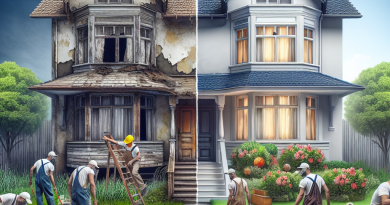Transforming Spaces: The Art of Renovation Staging
Transforming Spaces: The Art of Renovation Staging
Renovating a property can be a daunting task, but when done right, it can transform a space into a stunning showcase that attracts buyers and increases property value. One key aspect of successful renovation is staging – the art of decorating and furnishing a property to highlight its best features and appeal to potential buyers. In this article, we will explore the importance of renovation staging and provide tips for creating a successful staging strategy.
Why Renovation Staging Matters
Renovation staging is a crucial aspect of the selling process, as it helps potential buyers envision themselves living in the space. By showcasing the property in its best light, staging can increase the perceived value of the property and make it more attractive to potential buyers. Staging can also help highlight the key features of the property and minimize any flaws, creating a more appealing overall impression.
Creating a Successful Staging Strategy
When it comes to renovation staging, attention to detail is key. Here are some tips for creating a successful staging strategy:
1. Identify the target market: Before staging a property, it’s important to consider the target market and tailor the staging to their preferences. For example, if the property is in a family-friendly neighborhood, staging with family-friendly furniture and decor can help potential buyers envision themselves living in the space.
2. Highlight key features: When staging a property, focus on highlighting its key features. Whether it’s a stunning view, a beautiful fireplace, or a spacious kitchen, make sure these features are front and center during the staging process.
3. Declutter and depersonalize: To create a clean, inviting space, declutter and depersonalize the property. Remove personal items, excess furniture, and clutter to create a blank canvas that potential buyers can envision themselves living in.
4. Use neutral colors and styles: When staging a property, it’s best to use neutral colors and styles that appeal to a wide range of tastes. This can help create a cohesive, inviting space that appeals to a broad audience.
5. Create inviting outdoor spaces: Don’t forget about outdoor spaces when staging a property. Whether it’s a patio, balcony, or backyard, staging outdoor spaces with cozy furniture and attractive landscaping can create a welcoming first impression.
6. Lighting is key: Good lighting is essential for showcasing a property in its best light. Make sure to maximize natural light and add additional lighting where needed to create a bright, inviting space.
7. Don’t forget about the details: Pay attention to the small details when staging a property. This can include fresh flowers, scented candles, and upscale accessories that add a touch of luxury to the space.
Overall, renovation staging is an essential aspect of the selling process that can help transform a property into a stunning showcase that attracts buyers and maximizes property value. By following these tips and creating a successful staging strategy, you can create a space that potential buyers will fall in love with.






